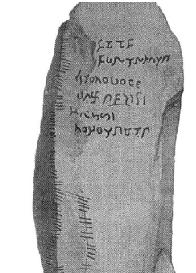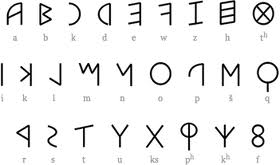It looks like you're using an Ad Blocker.
Please white-list or disable AboveTopSecret.com in your ad-blocking tool.
Thank you.
Some features of ATS will be disabled while you continue to use an ad-blocker.
share:
reply to post by Logarock
Keep in mind that it could have been a title.
Yes, rather than a name. Good point.
Another 'beak' stone, and again it could be Mug Ruith:
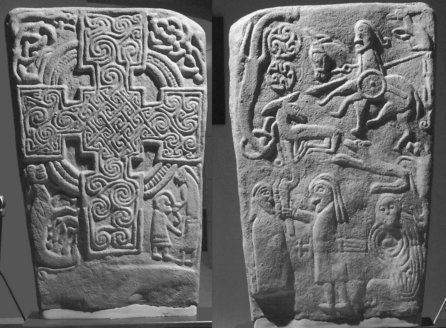
Another bizarre scene. The beaked figure is holding a stick with a U shaped end (a bit like an old can opener) up to another figure's face. The other side depicts a crouched figure with the beastie's 'hair' or tassle 'measuring (?) another figure's head.
ETA: Here's a clearer photo:
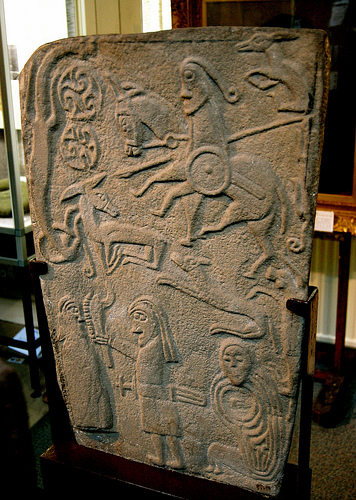
edit on 23-2-2014 by beansidhe because: eta
that can opener looks like a jaw bone with teeth
horse or cow
or the "jawbone of an ass..." of biblical fame
whats the dangley long apendaged thing on the top left I wonder
horse or cow
or the "jawbone of an ass..." of biblical fame
whats the dangley long apendaged thing on the top left I wonder
edit on 23-2-2014 by Danbones because: (no reason given)
on the other side looks like mother and child...
what is around the shorter figure's head and in the taller one's hands is hard to say.
judging by the lying down dog on the opposite corner, it looks like a home scene
or large person and small - aryan and pict maybe
what is around the shorter figure's head and in the taller one's hands is hard to say.
judging by the lying down dog on the opposite corner, it looks like a home scene
or large person and small - aryan and pict maybe
edit on 23-2-2014 by Danbones because: (no reason given)
reply to post by Danbones
It's also called the Samson stone, I've just discovered - so jawbone of an ass would be spot on. I don't know what the top left thing is - Nessie?
I'll need to read up on Samson to see if I can figure out the scene.
It's also called the Samson stone, I've just discovered - so jawbone of an ass would be spot on. I don't know what the top left thing is - Nessie?
I'll need to read up on Samson to see if I can figure out the scene.
This is very interesting:
And:
Wiki link
In August 2012, archaeologists from Tel Aviv University announced the discovery of a circular stone seal, approximately 15 millimetres in diameter, and apparently depicting a lion and a man. The seal was found on the floor of a house at Beth Shemesh and is dated to the 12th century BCE. Professor Shlomo Bunimovitz, a co-director of the dig, was reported as saying that the artifact helps "anchor the story [of Samson] in an archaeological setting."[40] According to Haaretz, "excavation directors Prof. Shlomo Bunimovitz and Dr. Zvi Lederman of Tel Aviv University say they do not suggest that the human figure on the seal is the biblical Samson. Rather, the geographical proximity to the area where Samson lived, and the time period of the seal, show that a story was being told at the time of a hero who fought a lion, and that the story eventually found its way into the biblical text and onto the seal."[41]
And:
Both heroes, champion of their respective people, die by their own hand: Herakles ends his life on a pyre while Samson makes the Philistine temple collapse upon himself and his enemies.
These views are disputed by traditional and conservative biblical scholars who consider Samson to be a literal historical figure and thus reject any connections to mythological heroes.[34] That Samson was a "solar hero" has been described as "an artificial ingenuity".[35] Some biblical scholars suggest that Samson's home tribe of Dan might have been related to the Philistines themselves. "Dan" might be another name for the tribe of Sea Peoples otherwise known as the Denyen, Danuna, or Danaans. If so, then Samson's origin might be entirely Aegean.[36] These speculations are in stark contrast to the historical depictions expressed in the Bible and are therefore mutually exclusive.
Wiki link
Among the Sea Peoples identified in Egyptian records are the Ekwesh, possibly a group of Bronze Age Greeks (Achaeans); the Denyen, identified by some with the Greek Danaoi and by others with the Israelite tribe of Dan; the Teresh; the Tyrrhenians, possibly ancestors of the Etruscans; Lukka, an Anatolian people of the Aegean who may have given their name to the region of Lycia and the Lycian language; the Sherden, possibly Sardinians or people of Sardis; the Shekelesh, identified possibly with the Italic people called Siculi (from Sicily); the Peleset, whose name is generally believed to refer to the Philistines, who might have come from Crete with the Tekrur (possibly Greek Teucrians) and who together were the only major member of the Sea Peoples thought to have migrated permanently to the Levant.[2] Evidence for migrations of whole peoples are not found on any of the contemporary inscriptions, but versions of a "migration hypothesis" represent the widely held interpretation among scholars of the ancient Near East.[8]
edit on 24-2-2014 by beansidhe because: Sea people info
reply to post by Logarock
Thanks, I'm looking forward to it
The last link you provided was really good, particularly the recent experiments with D.M.T. - it made me think about the chambered tombs in Scotland and how it would have felt to be part of that.
ETA: I sneaked a quick google of him and now I can't wait to hear his lecture!!
Thanks, I'm looking forward to it
The last link you provided was really good, particularly the recent experiments with D.M.T. - it made me think about the chambered tombs in Scotland and how it would have felt to be part of that.
ETA: I sneaked a quick google of him and now I can't wait to hear his lecture!!
edit on 24-2-2014 by beansidhe because: (no reason
given)
reply to post by Logarock
I could write for hours on this lecture and still not cover it.
I'm still trying to process it all. When he said he had helped rebuild the Govan shipyards, in Glasgow, he had my attention. I believe this man, he has nothing to prove, no academic credentials to maintain.
And he's right about the snobbery that is still rife, where Wales is considered a backwards, provincial nation; no mention of a Kingdom.
I'm a bit gobsmacked, really. But he started off with the same premise as us: our ancestors were not stupid. A royal line came to Britain, the Kumri/Cymry (with their P-celtic language) followed the cart, the Etruscan alphabet, the comet....
The most exciting thing is that, through your own research you were right, Logarock. That your findings correspond to this can not possibly be a weird coincidence - Etruscan was right.
Here's a copy of the Coelbren alphabet (and the wiki link, for interest)
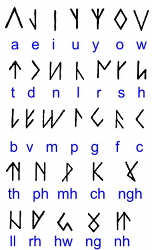
Coelbren
If this corresponds to our stone (and note, it wasn't Waddel who drew the inscription, that was done earlier) this is going to get really exciting!
I could write for hours on this lecture and still not cover it.
I'm still trying to process it all. When he said he had helped rebuild the Govan shipyards, in Glasgow, he had my attention. I believe this man, he has nothing to prove, no academic credentials to maintain.
And he's right about the snobbery that is still rife, where Wales is considered a backwards, provincial nation; no mention of a Kingdom.
I'm a bit gobsmacked, really. But he started off with the same premise as us: our ancestors were not stupid. A royal line came to Britain, the Kumri/Cymry (with their P-celtic language) followed the cart, the Etruscan alphabet, the comet....
The most exciting thing is that, through your own research you were right, Logarock. That your findings correspond to this can not possibly be a weird coincidence - Etruscan was right.
Here's a copy of the Coelbren alphabet (and the wiki link, for interest)

Coelbren
If this corresponds to our stone (and note, it wasn't Waddel who drew the inscription, that was done earlier) this is going to get really exciting!
reply to post by beansidhe
Yea and Wilson even comes at it from another direction. But looks like you were heading that way yourself.
Those Bronze age civilizations of the Med were actually quite advanced in many areas. We hear about the great bronze work of the chines but just look into those early bronze works, ships, building, sculpture, ect coming out of Ionia, Etruscan ect. The Etruscans were big into all that and mining.
Now Wilson talks about the spread of the old Celtic language. I heard a guy a while back talking about some old records of the Syrian Sargon era calling the northern Israelites the cymri, keltio ect. That whole northern kingdom of Israel was displaced and never returned. That's another long story.
And yea the devaluation of the ancient brits, Celts ect and giving Rome all the credit for bring civilization to the barbarian hordes is probably a large scale historical conspiracy for any number of reasons.
Yea and Wilson even comes at it from another direction. But looks like you were heading that way yourself.
Those Bronze age civilizations of the Med were actually quite advanced in many areas. We hear about the great bronze work of the chines but just look into those early bronze works, ships, building, sculpture, ect coming out of Ionia, Etruscan ect. The Etruscans were big into all that and mining.
Now Wilson talks about the spread of the old Celtic language. I heard a guy a while back talking about some old records of the Syrian Sargon era calling the northern Israelites the cymri, keltio ect. That whole northern kingdom of Israel was displaced and never returned. That's another long story.
And yea the devaluation of the ancient brits, Celts ect and giving Rome all the credit for bring civilization to the barbarian hordes is probably a large scale historical conspiracy for any number of reasons.
reply to post by Logarock
I had a pounding headache this morning - must have been all those neurons firing and re-routing last night!
What this means -at this moment - to me, is a reconsideration of the 'Samson' stone, and for that matter all the 'Christian' or biblical stones.
Samson could be a happy coincidence, but it strikes me that it has meaning that these people chose to depict an already ancient story, of a man from a misplaced tribe. I think I want to look at the other characters on the class 2 stones and see if they share a common theme, because if they do then I will be convinced we are on the right track!
I had a pounding headache this morning - must have been all those neurons firing and re-routing last night!
What this means -at this moment - to me, is a reconsideration of the 'Samson' stone, and for that matter all the 'Christian' or biblical stones.
Samson could be a happy coincidence, but it strikes me that it has meaning that these people chose to depict an already ancient story, of a man from a misplaced tribe. I think I want to look at the other characters on the class 2 stones and see if they share a common theme, because if they do then I will be convinced we are on the right track!
But first we should maybe reconsider this depiction, not of 2 Mug Ruith's with the head of John the Baptist, but possibly as 2 guardian ravens who
will tear the flesh from a man:


Im not so sure the language of which you speak is PICTish
more likely from roman influence if its in anyway Etruscan
Ill leave it to the experts
news.discovery.com...
more likely from roman influence if its in anyway Etruscan
Ill leave it to the experts
Lee explained that writing comes in two basic forms: lexigraphic writing that is based on speech and semasiography, which is not based on speech.
"Lexigraphic writing contains symbols that represent parts of speech, such as words, or sounds like syllables or letters, and tends to be written in a linear or directional manner mimicking the flow of speech," he said. "In semasiography, the symbols do not represent speech -- such as the cartoon symbols used to show you how to build a flat pack piece of furniture -- and generally do not come in a linear manner."
Although Lee and his team have not yet deciphered the Pictish language, some of the symbols provide intriguing clues. One symbol looks like a dog's head, for example, while others look like horses, trumpets, mirrors, combs, stags, weapons and crosses.
The later Pictish Stones also contain images, like Celtic knots, similar to those found in the Book of Kells and other early works from nearby regions. These more decorative looking images frame what Lee and his team believe is the written Pictish language.
"It is unclear at the moment whether the imagery, such as the knots, form any part of the communication," Lee said. He believes the stones also contain semasiographic symbols, such as a picture of riders and horn blowers next to hunting dogs on what is called the Hilton of Cadboll stone. Yet another stone shows what appears to be a battle scene.
Paul Bouissac, a University of Toronto professor who is one of the world's leading experts on signs and symbols, told Discovery News that he agrees "it is more than plausible that the Pictish symbols are examples of a script, in the sense that they encoded some information, which also had a spoken form."
news.discovery.com...
edit on 25-2-2014 by Danbones because: (no reason given)
the Etruscans did not disappear entirely from history. Their language and people, though a remnant, are the Basques of today. Though the Basques mixed with local populations over the past few millennia, their language didn't die. A number of scholars consider Euskara (Basque language) the closest living relative to ancient Etruscan. Euskara is an isolate language, meaning it did not descend from an ancestor common to any other language family known today.
The original Etruscan language (from ancient Etruscans in northwestern Italy) is thought to be an extinct isolate language, and there is agreement that the current Euskara language was already present in Western Europe before the arrival of other Indo-European languages.
Another interesting connection is to Georgian (language of Georgians in southern Russia), each of which have linguistic commonalities, prompting scholars to hypothesize Euskara has a relationship to a lost Eurasian superfamily of languages. This further supports the suggestion that Etruscans were originally Trojans.
After a succession of wars with the Greeks, around 1260 B.C. thousands of Trojans (speaking an ancient Thracian language) resettled abroad, which included Trojan warriors and families who sailed across the Black Sea to the Caucasus region in southern Russia, and also those who sailed to present-day northwest Italy.
Their descendants, the Basques, would eventually migrate into what is present-day southeast France and northeast Spain.
www.raceandhistory.com...
for what its worth maybe a few wound up in scotland around 1250 etc
edit on 25-2-2014 by Danbones because: spaced out text of quote..........lol
reply to post by Danbones
Yea they are pictographs. lol Your right, the icons used on the stones are not letters save for one. That's what we have been saying from the beginning.
The reason I was going back behind Rome is because of an old style flying disk on one of the stones and what is clearly an old style name iconography on another. That's way back in the first 5 pages of this thread I believe. The winged disk type is not of the Egyptian sort but is of the Assyrian/Babylonian sort, but the name icons look to be of the older Egyptian type before the classical cartouche was developed.
Yea they are pictographs. lol Your right, the icons used on the stones are not letters save for one. That's what we have been saying from the beginning.
The reason I was going back behind Rome is because of an old style flying disk on one of the stones and what is clearly an old style name iconography on another. That's way back in the first 5 pages of this thread I believe. The winged disk type is not of the Egyptian sort but is of the Assyrian/Babylonian sort, but the name icons look to be of the older Egyptian type before the classical cartouche was developed.
reply to post by Logarock
I was hoping you would tell me!
Ok, let me think. That lecture has left me reeling and I'm trying to pick holes in it, but so far - I can't. What he speaks about is accurate, in terms of the anti-Welsh agenda from present day Westminster. The English government has tried to destroy Scots Gaelic and it was only after devolution, that we in Scotland were 'allowed' to use Gaelic on road signs etc; in fact it was one of the first things the Scottish government did, and it was seen as pettiness by the English but of huge importance to the Scots.
You will hear English people mock it, saying Gaelic wasn't even spoken in Scotland - it damn well was. The Book of Deer is the oldest surviving example of Gaelic writing in the north east of Scotland, and it dates from the 12th century,
which gives a fairly good, if broad, picture of it's importance. North east, as you very well know, is prime Pictland and it was considered that we learned Gaelic from the Irish. In fact, Dal Riada was not Irish as we know it, as it incorporated parts of Ireland and the Argyll area of Scotland. It was, if anything, Scottish.
Anyway, I'm ranting but you can see how this can equally relate to the Welsh. It would pain middle England terribly to admit the Welsh any status out of nothing other than snobbery and ignorance.
So, that being said, I have to consider the fact that his lecture made some uncanny parallels with our thread.
We have Y Gododdin, which interestingly is sometimes disputed as a Welsh poem made up by a fanciful Welshman.
Written by a Pict.
So, for me, it is no stretch to see our Welsh-ish speaking Picts as at the very least allies of the Cymry.
In terms of the stones, then I am convinced that they do commemorate very, very important events of a Royal line arriving. I'm just not sure I can get my head round which line he's referring to just yet!
I was hoping you would tell me!
Ok, let me think. That lecture has left me reeling and I'm trying to pick holes in it, but so far - I can't. What he speaks about is accurate, in terms of the anti-Welsh agenda from present day Westminster. The English government has tried to destroy Scots Gaelic and it was only after devolution, that we in Scotland were 'allowed' to use Gaelic on road signs etc; in fact it was one of the first things the Scottish government did, and it was seen as pettiness by the English but of huge importance to the Scots.
You will hear English people mock it, saying Gaelic wasn't even spoken in Scotland - it damn well was. The Book of Deer is the oldest surviving example of Gaelic writing in the north east of Scotland, and it dates from the 12th century,
which gives a fairly good, if broad, picture of it's importance. North east, as you very well know, is prime Pictland and it was considered that we learned Gaelic from the Irish. In fact, Dal Riada was not Irish as we know it, as it incorporated parts of Ireland and the Argyll area of Scotland. It was, if anything, Scottish.
Anyway, I'm ranting but you can see how this can equally relate to the Welsh. It would pain middle England terribly to admit the Welsh any status out of nothing other than snobbery and ignorance.
So, that being said, I have to consider the fact that his lecture made some uncanny parallels with our thread.
We have Y Gododdin, which interestingly is sometimes disputed as a Welsh poem made up by a fanciful Welshman.
Written by a Pict.
So, for me, it is no stretch to see our Welsh-ish speaking Picts as at the very least allies of the Cymry.
In terms of the stones, then I am convinced that they do commemorate very, very important events of a Royal line arriving. I'm just not sure I can get my head round which line he's referring to just yet!
Paul Bouissac, a University of Toronto professor who is one of the world's leading experts on signs and symbols, told Discovery News that he agrees "it is more than plausible that the Pictish symbols are examples of a script, in the sense that they encoded some information, which also had a spoken form."
I don't mean to sound like a snob myself but considering you brought this guy in as an expert.....we have already come to this conclusion in the first few pages of the thread and have offered up a considerably larger justification for thinking so than this guy has. Not to mention this guys answerer is like duh. Really? If the above is any indication they should give me the chair of that department. lol
edit on 25-2-2014 by Logarock because: n
reply to post by Logarock
umm, the ARYANs /Phonecians that ruled the Picts ruled Sumeria before Egypt and Babylon, the Picts were in the area before the phonecians arrived but not before the phonecians existed..also the picts lived on for thousands of years after the arrival of the phonecians with their own culture.....
here is the picts language
www.fanad.net...
they don't know what it means but they list the symbols exactly and the explain all the various theories
if there is anything else on the stones when and where it came from is questionable
even if there is some script on the stones, its like they say: if it has hooves, its more likely a horse then a zebra
en.wikipedia.org...
www.ancient.eu.com...
The winged disk type is not of the Egyptian sort but is of the Assyrian/Babylonian sort, but the name icons look to be of the older Egyptian type before the classical cartouche was developed.
umm, the ARYANs /Phonecians that ruled the Picts ruled Sumeria before Egypt and Babylon, the Picts were in the area before the phonecians arrived but not before the phonecians existed..also the picts lived on for thousands of years after the arrival of the phonecians with their own culture.....
here is the picts language
www.fanad.net...
they don't know what it means but they list the symbols exactly and the explain all the various theories
if there is anything else on the stones when and where it came from is questionable
even if there is some script on the stones, its like they say: if it has hooves, its more likely a horse then a zebra
396 BC – Battle of Veii – Romans complete conquest of Etruscans
en.wikipedia.org...
It enters recorded history in the military reports of Julius Caesar, who crossed to the island from Gaul (France) in both 55 and 54 BCE. The Romans invaded the island in 43 CE, on the orders of emperor Claudius, who crossed over to oversee the entry of his general, Aulus Plautius, into Camulodunum (Colchester), the capital of the most warlike tribe, the Catuvellauni. Plautius invaded with four legions and auxiliary troops, an army amounting to some 40,000.
Due to the survival of the Agricola, a biography of his father-in-law written by the historian Tacitus (c. 105 CE), we know much about the first four decades of Roman occupation, but literary evidence is scarce thereafter; happily there is plentiful, if occasionally mystifying archaeological evidence. Subsequent Roman emperors made forays into Scotland, although northern Britain was never conquered; they left behind the great fortifications, Hadrian's Wall (c. 120 CE) and the Antonine Wall (142 -155 CE), much of which can still be visited today. Britain was always heavily fortified and was a base from which Roman governors occasionally made attempts to seize power in the Empire (Clodius Albinus in 196 CE, Constantine in 306 CE).
www.ancient.eu.com...
2350 - Sargon of Agade defeats Umma & takes over Sumer & Akkad & creates significant political & economic empire. Sargon tries to unite the area cults and makes his daughter Enheduanna the priestess/wife of the moon god Nanna. Enheduanna is the first known and named author.
2nd Millennium - 1st Half
Ascendancy of Amorite dynasties of Isin, then Larsa, then Babylon. This period ends with devastating Hittite raid around 1600 B.C.
1795 - Rim-Sin of Larsa defeats Isin & takes over Sumer & Akkad
ancienthistory.about.com...
www.mysteriousetruscans.com...
The origin of the Etruscan alphabet is not in doubt. The first alphabet was invented by Semitic-speakers in the ancient Near East, though the Caananite and later Phoenician alphabets had only consonants, and no vowels. The Greeks derived their alphabet from the Phoenicians and added vowels, producing the first true alphabet. A western variety of the Greek alphabet was carried by the Euboean Greeks to Italy, and the Etruscans acquired the alphabet from them. The Etruscans in turn passed on the alphabet to the Romans.
its just graphitti
edit on 25-2-2014 by Danbones because: (no reason given)edit on 25-2-2014 by Danbones because: (no reason given)
new topics
-
Happy Thanksgiving to ATS
General Chit Chat: 56 minutes ago -
Simple Thanksgiving
Food and Cooking: 7 hours ago -
Trump could make a peaceful American Revolution
US Political Madness: 10 hours ago -
Trump Presidential Transition Team will not use GSA or Government entities to come to DC
US Political Madness: 11 hours ago -
Mind Blowing Cave under someones land
Fragile Earth: 11 hours ago
top topics
-
V.P. Kamala Harris releases a video and nobody understands why
US Political Madness: 15 hours ago, 16 flags -
Mind Blowing Cave under someones land
Fragile Earth: 11 hours ago, 16 flags -
The Party of Peace - Trump Cabinet Picks Targeted with Death Threats
US Political Madness: 12 hours ago, 15 flags -
Trump could make a peaceful American Revolution
US Political Madness: 10 hours ago, 14 flags -
Trump Presidential Transition Team will not use GSA or Government entities to come to DC
US Political Madness: 11 hours ago, 13 flags -
Simple Thanksgiving
Food and Cooking: 7 hours ago, 13 flags -
Happy Thanksgiving to ATS
General Chit Chat: 56 minutes ago, 2 flags
active topics
-
Mind Blowing Cave under someones land
Fragile Earth • 17 • : Owlwatcher -
Happy Thanksgiving to ATS
General Chit Chat • 2 • : GENERAL EYES -
Trump Presidential Transition Team will not use GSA or Government entities to come to DC
US Political Madness • 12 • : 777Vader -
Simple Thanksgiving
Food and Cooking • 26 • : Station27 -
The Party of Peace - Trump Cabinet Picks Targeted with Death Threats
US Political Madness • 27 • : DBCowboy -
President-Elect DONALD TRUMP's 2nd-Term Administration Takes Shape.
Political Ideology • 256 • : WeMustCare -
-@TH3WH17ERABB17- -Q- ---TIME TO SHOW THE WORLD--- -Part- --44--
Dissecting Disinformation • 3389 • : Crazierfox -
I thought Trump was the existential threat?
World War Three • 113 • : WeMustCare -
Mood Music Part VI
Music • 3719 • : MRTrismegistus -
Tunnels of Terror: The Cryptid Connection The Why Files
Cryptozoology • 5 • : TheMisguidedAngel

